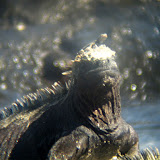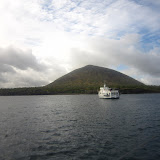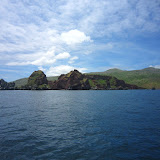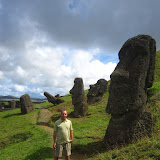Green Sea Turtle and Me
I'm back on land after a week on a sailboat. The eruption in Iceland of the Eyjafjallajökull volcano (pronunciation here) meant that a number of Europeans had to cancel their trips, meaning there were only six of us on the sixteen-passenger Cachalote. It turned out that was just the start of a run of good luck.
Before I arrived in Galapagos last week, I was actually a bit concerned. This is my last stop before returning home to New York. How could I possibly put a proper cap on the trip of a lifetime? Moreover, this place has always fully captured my imagination. It seemed impossible for Galapagos to meet my unreasonably high expectations, especially coming on the heels of all the remarkable things I've seen in the last three and a half months.
Well, I was clearly underestimating the wonders of the Galapagos archipelago. I thought I had things figured out when I wrote last week about the pelicans, sea lions, and iguanas I've been seeing. Then I got in the water, and I experienced an entirely different world. It seemed like every time in the water, the islands threw something new my way, and each experience even more mind-boggling than the last.
Swimming with sea lions was cool. They're extremely curious and playful, and will often swim right up to you and go around in circles, trying to figure out what you are before swimming off. I was amazed and even gleeful.
Then I swam with sea turtles. They're not as playful as the sea lions, but they're certainly beautiful and mesmerizing. They're also very easy to follow for a while, because they don't generally move much faster than people. They can when they want to, but don't generally seem to feel the need.
Then I swam with a shark. Not a big one. It was a white-tipped reef shark, which is about as long head-to-tail as I am head-to-toe. Lest you fear for me, it's also worth noting that they're completely indifferent to people.
So, I was astounded by all I had experienced. Using the underwater case I got for my camera, I got great pictures.* I was extremely pleased with all I had seen and experienced.
Then I swam with a penguin.
I had taken my head out to talk to some of my fellow Cachalote passengers, when I heard the unmistakable call of a Galapagos Penguin**--it sounds like a little lamb looking for its mother. I shouted to my fellow passengers, "penguin!" and swam toward it. And there it was, tiny head above water, occasionally dipping below the surface. Just a few feet in front of me, and swimming toward--and then right past--me. I can't express how incredible that brief moment was (it swam off at a speed I couldn't match within a minute or two). Galapagos penguins are the northernmost penguins in the world--the only ones that ever travel north of the Equator. This is one of the few places where you have the opportunity to swim around with a little snorkel and mask, and look up to see the world's most adorable flightless waterfowl paddling your way, taking its head out of the water and calling out for a compatriot of the same species.
I lined up my camera, and had the penguin perfectly centered in the frame. What I, infuriatingly, didn't realize until a few minutes later is that my memory card was full. For the first time on this trip, I had forgotten to make sure there was room on my camera before going off to do something of which I'd want pictures. On the plus side, I found this picture that someone posted, which is almost exactly what I saw, though from the other side. But I've been kicking myself for the last 48 hours.
It's worth noting that if I didn't already know that there were penguins here, I wouldn't have believed it. When you're getting sunburns in 80 degree heat, you just don't expect to look out at the water and see a bird most commonly associated with Antarctica. Of course, now that I know that there are Flamingos in the Andes (as well as here, by the way), I suppose I'm a bit less surprised by the spread of interesting birds.
Of course, the underwater inhabitants aren't the only fascinating thing about Galapagos. After all, the birds are even more famous, and Darwin himself was most interested in the volcanic geology and fresh lava flows. So it is that the most impressive fact of the Galapagos once one leaves the comforts of Puerto Ayora is how unspoiled it all is. There is an extremely focused--and successful--effort to preserve the ecosystem and let it progress naturally. So it is that one sees huge colonies of marine iguanas--swimming iguanas that exist nowhere else, solitary and enormous land iguanas, flightless cormorants--which have evolved into swimming birds with awkward and useless vestigial wings, enormous albatross, and thousands upon thousands of specacular blue-footed boobies--which live up to their name with nearly flourescent webbed feet. These creatures don't really seem to care one way or the other about people, and so don't bother to flee when you approach, creating amazing opportunities for observation and picture-taking. I've been in Galapagos for a week and a half now, and I'm still having a hard time believing this place is real. When people ask how it is, I have a hard time saying anything other than "almost fictional." It really just seems like someone's imagined version of a wildlife paradise.
Before I head off to figure out my plans for my last week on the islands, I want to take a moment to thank Juan Tapia, the spectacular guide who led our Cachalote group around several islands for the last week. Juan has 21 years of knowledge crammed into his brain, and he shared a sizeable amount of it with us. He knew exactly when and where to take us so that we almost completely missed the other tour groups. If you look through my pictures, you will rarely see anyone other than Juan or one of the other five Cachalote passengers. If you ever make your way down to Galapagos, hope that you're lucky enough to get a guide as excellent and professional as Juan. And if you bring along a guitar, you might--as we did--be able to get him to play you "Besame Mucho."
At any rate, although I'm still recovering from the last week aboard the Cachalote--sleeping on a sailboat for a week means that sleeping on shore again feels like you're rocking back and forth--I should get going and figure out what I'm going to do for an encore. It's going to be hard to top the last week--completely unique in my life to date--but I now have a great deal of confidence in the endless array of surprises that lay hidden in the various corners of these incredibly special islands.
Saludos,
Seth
*As of this writing I have a bit fewer than half of my pictures uploaded, and none of the videos. Internet is very slow out here, so most of this will likely have to wait until I've returned home to the states.
**One thing that our group observed is that there's an easy way to guess the name of the species of animal you're looking at. It's almost certainly the Galapagos _______, where the blank is filled in with the type of animal it is. See also the Galapagos Hawk, Galapagos Shark, Galapagos Land Iguana, Galapagos Marine Iguana, Galapagos Tortoise, Galapagos Flightless Cormorant--with which I also swam, Galapagos Cotton (the plant), and so on. These islands are so isolated that so many species of life here have evolved completely separately from their counterparts in the rest of the world.
Fotografía:
 |
| Galapagos - Española - Gardner Bay |
 |
| Galapagos - Española - Punta Suárez |
 |
| Galapagos - Floreana - Champion Rock |
 |
| Galapagos - Floreana - Punta Cormorán |
 |
| Galapagos - Floreana - Post Office Bay |
 |
| Galapagos - Isabela - Punta Moreno |
 |
| Galapagos - Isabela - Elizabeth Bay |
 |
| Galapagos - Isabela - Urvina Bay |
 |
| Galapagos - Fernandina - Punta Espinosa |
 |
| Equator |
 |
| Galapagos - Santiago - James Bay |
 |
| Galapagos - Bartolomé |
 |
| Galapagos - Santa Cruz - Black Turtle Cove |

























